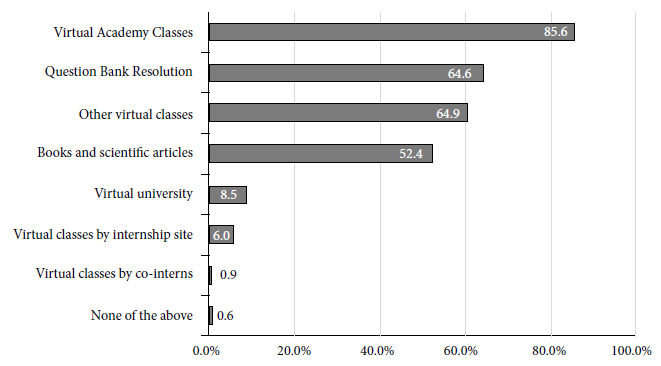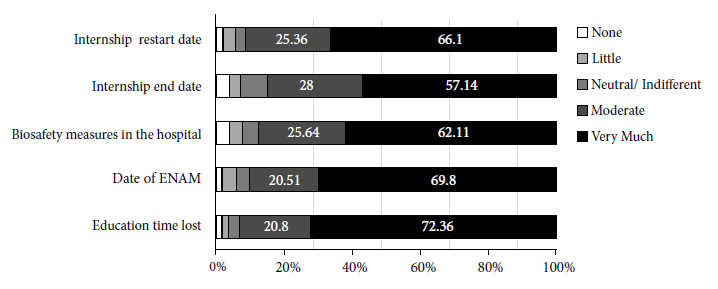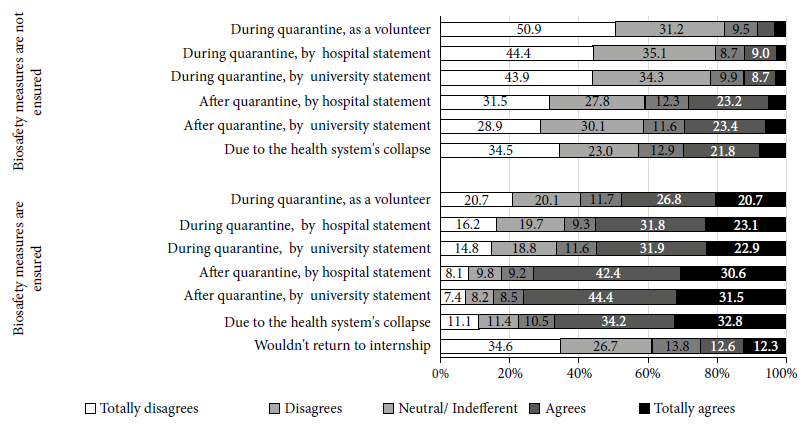Services on Demand
Journal
Article
Indicators
-
 Cited by SciELO
Cited by SciELO
Related links
-
 Similars in
SciELO
Similars in
SciELO
Share
Revista Peruana de Medicina Experimental y Salud Publica
Print version ISSN 1726-4634
Rev. perú. med. exp. salud publica vol.37 no.3 Lima Jul-Sep 2020
http://dx.doi.org/10.17843/rpmesp.2020.373.5729
Brief report
Interns' perceptions about the medical internship suspension during the COVID-19 quarantine
1 Sociedad Científica Médico Estudiantil Peruana, Lima, Perú.
2 Facultad de Medicina, Universidad Nacional de Trujillo, Trujillo, Perú.
3 Facultad de Ciencias de la Salud, Universidad Señor de Sipán, Chiclayo, Perú.
4 Facultad de Ciencias de la Salud, Universidad Andina Néstor Cáceres Velásquez, Juliaca, Perú.
5 Facultad de Ciencias de la Salud, Universidad Nacional de Piura, Piura, Perú.
INTRODUCTION
The medical internship consists of pre-professional practices during the last year of medical school 1. After this year, medical interns (MIs) take the National Medical Exam (ENAM). Completing the the internship and passing ENAM are requirements to become a member of the Peruvian Medical Association and practice medicine in Peru 2.
In March 2020, the Peruvian government took measures to control the spread of COVID-19, including the suspension of educational activities 3. Thus, universities and hospitals suspended all undergraduate academic activities 4. As of May 2020, the Peruvian authorities had not set the conditions, nor the date of a possible resumption of the internship. This study aimed to describe the MIs’ perceptions on the suspension of medical internship during the COVID-19 quarantine in Peru.
KEY MESSAGES
Motivation for the study: As a result of the COVID-19 pandemic, the medical internship was suspended for a long time, affecting the training of medical interns in Peru.
Main findings: The intention to return to medical internship increases if biosecurity measures are ensured and quarantine ends. Most interns invest their time in preparing to take the National Medical Examination.
Implications: This is the first report on medical interns’ perceptions on the suspension of internship during the COVID-19 pandemic in Peru. In the event of a return to medical internship, biosafety and academic training should be ensured.
Design and participants
A cross-sectional descriptive study conducted on medical interns in Peru. It included an estimated population of 3500 MIs from 45 medical schools created before 2014, 55.4% of whom were women 4 - 6. MIs who consented to participate in the study were selected. A pilot study was conducted with 14 MIs, who were asked whether they found the survey’s questions and answers difficult to understand. Data collection took place April 15-20, 2020, during the fifth week of quarantine. Those who participated in the pilot study or who stated that they had previously answered the survey were excluded.
Survey
A 24-question ad hoc survey was designed (Appendix 1) to be completed in approximately 15 minutes. It included sociodemographic data: age, university of origin, place of internship, health insurance, city of internship, people living together and their health condition, marital status, and children; questions about the agreement regarding the suspension of the internship during quarantine and their opinion on recovering one month of internship in January 2021; their reasons to be for or against the internship suspension and the motives and conditions for resuming the internship. In addition, we investigated the degree of uncertainty regarding education, the dates of return and the end of internship, and the date for the ENAM. All responses were presented on the five-option Likert scale. Finally, MI’s were asked about their academic and extracurricular activities during the quarantine.
Procedures
The interns were contacted through their delegates (participants in the Peruvian Association of Human Medicine Interns) 7 and were and asked to disseminate the survey on the social networks (WhatsApp and Facebook) of the MIs’ respective universities; to do so, they were given instructions and a standardized message. The snowball method was used by asking each participant to replicate the invitation sent among their MI contacts. A sample of 347 interns was calculated with OpenEpi version 3, considering an expected frequency of 50% of intention to return to the internship, with a statistical power of 80% and a 95% confidence interval. The survey was self-administered using Google Forms platform (www.docs.google.com/forms).
Statistical analysis
The analysis was performed using STATA 14.0 (Stata Corp, TX, USA). Sample characteristics were described using proportions for categorical variables, and medians and interquartile ranges (IQR) for numerical variables, after the normality assessment. Bar charts were used to describe responses according to the Likert scale.
Ethics
The project was approved by the Research Ethics Committee for COVID-19 of the Instituto de Evaluación de Tecnologías Sanitarias e Investigación of the Seguro Social del Perú (EsSalud), under the category of exempt review. The study protocol was registered in the PRISA repository of the Instituto Nacional de Salud del Perú (code: EI00000824).
FINDINGS
A total of 381 participants answered the survey, 28 were excluded (9 did not sign informed consent, 14 had previously participated, and 5 were not MIs). Finally, data from 353 MIs (94.0% of the total) from 41 Peruvian universities were analyzed (Appendix 2). The median age was 25 years (IQR: 23-26), 230 (65.2%) were students from private universities; 257 (72.8%) had health or accident insurance, 196 (55.5%) were receiving remuneration, and 232 (65.7%) declared to live with people at high risk of infection by COVID-19 (Table 1).
Table 1 Characteristics of the sample studied (n = 353).
| Characteristics | n (%) |
|---|---|
| Age (years) a | 25 (23-26) |
| University type | |
| National | 123 (34.8) |
| Private | 230 (65.2) |
| Internship type | |
| MINSA | 270 (76.5) |
| EsSalud | 44 (12.5) |
| Healthcare and Armed Forces | 25 (7.1) |
| Private | 14 (4.0) |
| Remunerated internship | |
| No | 157 (44.5) |
| Yes | 196 (55.5) |
| Internship in the university campus | |
| No | 101 (28.6) |
| Yes | 252 (71.4) |
| Health insurance type b | |
| SIS | 134 (38.0) |
| EsSalud | 44 (12.5) |
| Private insurance | 43 (12.2) |
| University insurance | 37 (10.5) |
| Insurance by internship location | 30 (8.5) |
| Healthcare and Armed Forces | 5 (1.4) |
| None | 96 (27.2) |
| Persons with MI during internship | |
| Family core | 215 (60.9) |
| Lives alone | 78 (22.1) |
| Other family members | 30 (8.5) |
| Friends | 30 (8.5) |
| Lives with people at risk for COVID-19 | |
| No | 121 (34.3) |
| Yes | 232 (65.7) |
| Children | |
| No | 327 (92.6) |
| Yes, and they are financially dependent on the MI | 17 (4.8) |
| Yes, and they are not financially dependent on the MI | 9 (2.6) |
MI: medical intern, SIS: Seguro Integral de Salud, MINSA: Ministerio de Salud; EsSalud: Seguro Social de Salud.
a Median and interquartile range, b possibility to check more than one option.
The majority (74.8%) of the MIs agreed with the internship suspension; 81.1% agreed or strongly agreed with the suspension because hospitals did not guarantee biosecurity measures; 76.2%, because it was a risk for family members or people close to them; 62.0%, because they were still students; 38.5%, because they did not feel qualified to face a pandemic; and 37.7%, because they did not receive a salary. On the other hand, 53.1% agreed or strongly agreed against the suspension because it was a good learning opportunity; 48.0%, because the MI provides essential work; and 51.4%, because the health system would collapse without the MIs. At the time of the survey, 70.0% agreed to continue in quarantine.
Of the participants, 91.5% reported feeling very or moderately uncertain about the restart of the internship, and 85.1%, very much or moderately uncertain about its completion. On the other hand, 90.3% felt moderate or very uncertain about the date of the ENAM (Figure 1). The majority (85.6%) participated in virtual classes to prepare for ENAM (Figure 2).

Figure 2 Academic activities carried out by medical interns participating in the study during quarantine by COVID-19.
Regarding biosecurity measures and equipment not being guaranteed, only 11.9% agreed or totally agreed to return to hospitals during quarantine. Under these conditions, 29.6% agreed or totally agreed to return in the event of a collapse of the health system. If biosecurity measures and equipment were guaranteed, 54.9% agreed or fully agreed to return to their hospital sites during quarantine; and 72.9% if the return was after quarantine. However, 24.9% agreed or totally agreed not to return to the hospital despite the guarantee of biosecurity measures (Figure 3). When asked about their position on recovering one month of internship in January 2021, 41.9 % agreed or strongly agreed, and 48.2 % disagreed or strongly disagreed.
DISCUSSION
Less than half of the MIs agree to return to the internship if biosecurity measures are not guaranteed. This perception increases when biosecurity measures are guaranteed and the quarantine ends. On the other hand, there is great uncertainty about the restart and end dates of the internship. In turn, most respondents invest their time in preparing for the ENAM.
During the internship, MIs are exposed to develop mental disorders, suffer aggressions, and work accidents 1 , 8 , 9, in addition, the scarcity of protection equipment and the lack of adequate biosecurity training are highlighted 8. The 2020 MIs carried out their activities for more than two months and probably observed limitations in the health systems. Perhaps because of this, almost all of them feel great uncertainty about the availability of biosafety equipment and do not agree to return to their activities if their protection is not guaranteed.
Previously, MIs groups suspended their activities for some weeks demanding better working conditions 10. During the 2009 AH1N1 pandemic, MIs continued their activities normally 11. However, the COVID-19 pandemic resulted in the interruption of several months of internship, with the possibility of suspending the entire academic year. In the face of this, MIs have felt uncertain about their education. On the other hand, prolonging the internship would postpone the 2020 ENAM and begin the internship in 2021. However, half of the MIs would not support the extension of the internship.
Other countries are facing their own reality during the pandemic. Mexico also suspended the internship due to lack of biosafety equipment 12. However, other countries involved MIs or seniors in the fight against the pandemic 13. Thus, degree processes were earlier in some universities in the United States 14, Colombia 15, and Ireland 16, prioritizing the number of available personnel over formal education of MIs. It is important to consider that in these countries MIs start to work midyear and at the time of the pandemic they were close to completing their internship.
During quarantine, MIs spend their time mainly studying through virtual classes for the ENAM. This is probably due to the recent obligation to pass the ENAM to become a member of the Peruvian Medical Association 2, and because many students perceive that the knowledge provided by their universities is not sufficient to take the ENAM 17. On the other hand, more than half of the respondents used virtual classes or conferences for their education, not necessarily related to ENAM but probably in the context of the pandemic 18. Despite this, trainings at their universities or hospital sites are not frequent. This was a missed opportunity, as virtual clinical discussions could have been held and MIs involved in virtual orientation to the population and identification of risk groups 19.
The limitations were the following: the sample was not representative of the MI population in Peru, since the selection of participants was not randomized. The sex variable was not included due to an error in the design of the survey. A non-validated instrument was used, with the possibility of a particular interpretation by each participant; however, with the realization of the pilot, the intention was to diminish this possibility. These conditions could underestimate the results of the study. Despite these limitations, this is the first report of MIs’ perceptions on the pandemic in Peru that evidences an intention to return to medical internship, but under appropriate conditions. In addition, it provides insight into the uncertainty that MIs are currently experiencing regarding their academic future.
In conclusion, in a sample of MIs from Peru, the intention to return to boarding school increases if biosecurity measures are guaranteed and the quarantine is terminated. On the other hand, there is great uncertainty about the dates of return and termination of the internship. In turn, most interns invest their time in preparing for the ENAM. We recommend that universities encourage virtual training by focusing on the resolution of real clinical cases. In addition, hospital centers, in coordination with universities, should guarantee the safety, well-being and health coverage of MIs if they intend to return to their hospital sites.
REFERENCES
1. Taype-Rondán Á, Tataje Rengifo G, Arizabal A, Alegría Hernández S. Percepción de médicos de una universidad de Lima sobre su capacitación en procedimientos médicos durante el internado. An Fac Med. 2016;77(1):31-8. doi: 10.15381/anales.v77i1.11550. [ Links ]
2. Morán-Ortiz J, Cabani-Ravello L. Aprobar el Examen Nacional de Medicina será obligatorio para ejercer como médico cirujano en el Perú. Acta Med Peru. 2019;36(1):3-4. [ Links ]
3. Gobierno del Perú. Decreto supremo No 064-2020-PCM. Decreto Supremo que prorroga el Estado de Emergencia Nacional por las graves circunstancias que afectan la vida de la nación a consecuencia del COVID-19 y dicta otras medidas [Internet]. El Peruano. 2020 [citado el 11 de abril de 2020]; Disponible en: https://busquedas.elperuano. pe/normaslegales/decreto-supremo-que-prorroga-el-estado-de-emergencia- naciona-decreto-supremo-no-064-2020-pcm-1865482-3/. [ Links ]
4. Asociación Peruana de Facultades de Medicina [Internet]. Lima: ASPEFAM; 2020 [citado el 27 de abril de 2020]; Disponible en: http://www.aspefam.org.pe/. [ Links ]
5. Mayta-Tristán P, Cuentas M, Núñez-Vergara M. Responsabilidad de las instituciones ante la proliferación de escuelas de medicina en el Perú. Acta Med Peru 2016;33:178-82. doi: 10.35663/amp.2016.333.109. [ Links ]
6. DATA ENCUESTA INTERNOS APIMH [Internet]. APIMH2020 [citado el 12 de junio de 2020]; Disponible en: https://figshare.com/s/b2cb31fc-99f54ac504ac. [ Links ]
7. Asociación Peruana de Internos de Medicina Humana [Internet]. Lima: APIMH; 2020 [citado el 21 de junio de 2020]; Disponible en: https://web.facebook.com/APIMH. [ Links ]
8. Nieto-Gutierrez W, Taype-Rondán A, Bastidas F, Casiano-Celestino R, Inga-Berrospi F. Percepción de médicos recién egresados sobre el internado médico en Lima, Perú 2014. Acta Med Peru. 2016;33:105-10. doi: 10.35663/amp.2016.332.59. [ Links ]
9. Charca-Benavente LC, Huanca-Ruelas GH, Moreno-Loaiza O. Biological accidents in last year medical students from three hospitals in Lima Peru. Medwave 2016;16:e6514. doi: 10.5867/medwave.2016.07.6514. [ Links ]
10. Nieto-Gutiérrez W, Bendezú-Quispe G, Taype-Rondan Á. ¿Por qué hacen huelga los internos de Medicina en Perú?. Rev Med Chil. 2016;144:538-9. doi: 10.4067/S0034-98872016000400020. [ Links ]
11. Bravo K, Gamarra M, Gonzales S, Lecca D, Martínez A, Mendoza M, et al. Nivel de conocimientos sobre la influenza A H1N1 en los trabajadores de salud del Hospital Nacional Arzobispo Loayza, Perú. Rev Per Epidemiol. 2009;13:1-7. [ Links ]
12. Infobae. Se reincorporarán 7,000 médicos internos al IMSS: no atenderán pacientes de COVID-19 [Internet]. Lima: Infobae; 2020 [citado el 27 de abril de 2020]; Disponible en: https://www.infobae.com/america/mexico/2020/04/27/se-reincorporaran-7000-medicos-internos-al-imss-no-atenderan-pacientes-de-covid-19/. [ Links ]
13. Miller DG, Pierson L, Doernberg S. The Role of Medical Students During the COVID-19 Pandemic. Ann Intern Med. 2020. doi: 10.7326/M20-1281. [ Links ]
14. Murphy B. COVID-19: States call on early medical school grads to bolster workforce [Internet]. Am. Med. Assoc.2020 [citado el 27 de abril de 2020]; Disponible en: https://www.ama-assn.org/delivering-care/public-health/covid-19-states-call-early-medical-school-grads-bolster-workforce. [ Links ]
15. El Espectador. Universidad del Rosario adelantará grados a estudiantes de medicina de último semestre [Internet]. Bogota: El Espectador; 2020 [citado el 27 de abril de 2020]; Disponible en: https://www.elespectador.com/noticias/bogota/universidad-del-rosario-adelantara-grados-estudiantes-de-medicina-de-ultimo-semestre-articulo-912682. [ Links ]
16. O'Brien C. Coronavirus: Hundreds of medicine students fast-tracked into fight against Covid-19 [Internet]. The Irish Times; 2020 [citado el 27 de abril de 2020]; Disponible en: https://www.irishtimes.com/news/education/coronavirus-hundreds-of-medicine-students-fast-tracked-in-to-fight-against-covid-19-1.4205676. [ Links ]
17. Mejia CR, Ruiz-Urbina FN, Benites-Gamboa D, Albitres-Flores L, Mena LS, Fasanando-Vela R. Percepciones de utilidad y preparación para el Examen Nacional de Medicina en 10 facultades peruanas, 2017. Educ Medica. 2019;20:124-30. doi: 10.1016/j.edumed.2017.10.021. [ Links ]
18. Quijano-Escate R, Rebatta-Acuña A, Garayar-Peceros H, Gutierrez-Flores EK, Bendezu-Quispe G. Aprendizaje en tiempos de aislamiento social: cursos masivos abiertos en línea sobre la COVID-19. Rev Peru Med Exp Salud Publica. 2020;37. doi: 10.17843/rpmesp.2020.372.5478. [ Links ]
19. Bauchner H, Sharfstein J. A Bold Response to the COVID-19 Pandemic. JAMA. 2020. doi: 10.1001/jama.2020.6166. [ Links ]
Received: May 05, 2020; Accepted: June 24, 2020











 text in
text in 




